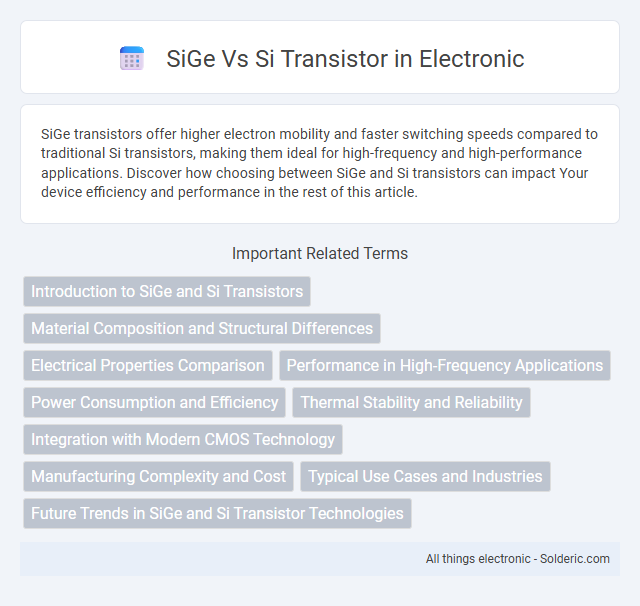SiGe transistors offer higher electron mobility and faster switching speeds compared to traditional Si transistors, making them ideal for high-frequency and high-performance applications. Discover how choosing between SiGe and Si transistors can impact Your device efficiency and performance in the rest of this article.
Comparison Table
| Feature | SiGe Transistor | Si Transistor |
|---|---|---|
| Material | Silicon-Germanium (SiGe) alloy | Pure Silicon (Si) |
| Electron Mobility | Higher | Lower |
| Cutoff Frequency (fT) | Up to 300 GHz | Typically below 100 GHz |
| Speed | Faster switching speeds | Slower switching speeds |
| Noise Performance | Lower noise figure | Higher noise figure |
| Power Consumption | Lower power consumption | Higher power consumption |
| Cost | Higher manufacturing cost | Lower cost, mature technology |
| Applications | High-frequency RF circuits, amplifiers, wireless comms | General-purpose digital and analog circuits |
| Thermal Stability | Better at high temperatures | Moderate thermal stability |
Introduction to SiGe and Si Transistors
SiGe (Silicon-Germanium) transistors leverage a SiGe alloy in the base region, providing enhanced carrier mobility and higher cutoff frequencies compared to traditional Si (Silicon) transistors. Si transistors dominate in standard CMOS technology due to their mature fabrication processes and cost-effectiveness, while SiGe devices excel in high-speed and RF applications with improved thermal stability. The semiconductor industry's shift towards SiGe enables advanced performance in mixed-signal and high-frequency integrated circuits.
Material Composition and Structural Differences
SiGe transistors incorporate a silicon-germanium alloy in their base region, enhancing carrier mobility and allowing faster electron transport compared to pure silicon transistors, which use a homogenous silicon structure. The graded SiGe base creates a heterojunction that reduces base transit time, leading to improved high-frequency performance and lower power consumption. Your choice between SiGe and Si transistors impacts device speed, thermal stability, and integration complexity due to these intrinsic material and structural differences.
Electrical Properties Comparison
SiGe transistors exhibit superior electrical properties compared to traditional Si transistors, including higher electron mobility and faster switching speeds due to the strained silicon-germanium alloy. This results in lower base resistance and improved current gain, enhancing overall device performance in high-frequency and high-speed applications. Your circuits benefit from reduced power consumption and increased efficiency when utilizing SiGe technology over pure silicon counterparts.
Performance in High-Frequency Applications
SiGe transistors excel in high-frequency applications due to their superior electron mobility and higher cutoff frequencies compared to traditional Si transistors, enabling faster signal processing and enhanced amplification. Their heterojunction structure reduces base resistance and transit time, resulting in improved gain and noise performance at microwave and millimeter-wave frequencies. Your high-frequency circuit designs benefit from SiGe technology's ability to operate efficiently at frequencies exceeding 100 GHz, which surpasses the capabilities of standard Si transistors.
Power Consumption and Efficiency
SiGe transistors exhibit significantly lower power consumption compared to traditional Si transistors due to their higher electron mobility and improved transistor switching speeds. This enhanced efficiency translates to reduced thermal losses and longer battery life in portable devices. When optimizing Your circuit design for power efficiency, SiGe technology offers a superior solution, especially in high-frequency and low-power applications.
Thermal Stability and Reliability
SiGe transistors exhibit superior thermal stability and reliability compared to traditional Si transistors due to their enhanced material properties and reduced leakage currents at high temperatures. The strain-engineered SiGe channel improves carrier mobility while maintaining performance under thermal stress, which extends device lifespan in demanding applications. Your choice of SiGe technology ensures better endurance and consistent operation in environments with elevated temperatures.
Integration with Modern CMOS Technology
SiGe transistors exhibit superior integration capabilities with modern CMOS technology due to their compatibility with standard silicon fabrication processes and minimal disruption to existing manufacturing workflows. The heterojunction structure of SiGe enables enhanced carrier mobility and improved device performance without requiring significant changes in CMOS integration, facilitating seamless adoption in advanced node technologies. This compatibility supports scaling while delivering higher speed and lower power consumption compared to conventional Si transistors in integrated circuits.
Manufacturing Complexity and Cost
SiGe transistors involve more complex manufacturing processes due to the need for precise epitaxial growth of silicon-germanium layers, which increases production time and equipment costs compared to traditional silicon transistors. The integration of SiGe requires advanced doping techniques and strain engineering to optimize performance, further elevating fabrication expenses. Consequently, SiGe transistor fabrication incurs higher overall costs while offering improved electronic properties that can justify the investment in high-performance applications.
Typical Use Cases and Industries
SiGe transistors excel in high-frequency and high-speed applications, making them ideal for telecommunications, radar systems, and wireless infrastructure industries. Si transistors dominate general-purpose electronics, power management, and consumer devices due to their cost-effectiveness and mature manufacturing processes. Your choice depends on performance requirements and budget constraints within sectors like automotive, aerospace, and mobile communication.
Future Trends in SiGe and Si Transistor Technologies
SiGe transistor technology is advancing with enhanced strain engineering and higher cutoff frequencies, enabling superior performance in high-speed and RF applications compared to traditional Si transistors. Future trends indicate SiGe devices will integrate more seamlessly with silicon CMOS, offering improved power efficiency and scalability for next-generation 5G, 6G, and IoT systems. As Si transistor scaling approaches physical limits, SiGe's ability to maintain carrier mobility and reduce short-channel effects positions it as a crucial technology for continued semiconductor innovation.
SiGe vs Si transistor Infographic

 solderic.com
solderic.com